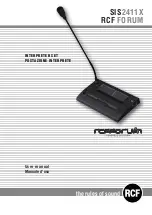
Global P4: Wave Sequence 4–2: Per-Step Parameters
671
Xfade
[0ms…10 sec]
This determines the time it takes to fade into the
next
step. For example, Step 1’s Crossfade determines the
time to fade between Step 1 and Step 2.
Crossfades use millisecond units for both
Time
and
Tempo
modes.
Note:
In
Time
mode, the
Xfade
time cannot exceed the
total duration of the two steps being crossfaded; in
Tempo
mode, it cannot exceed twice the duration of
the shorter of the two steps.
The
Fade-In
and
Fade-Out Shape
parameters, below,
allow linear, equal-power, and custom crossfades.
Fade-Out Shape
[Off, Log, -126…-1,
Linear, +1…126, Exp]
This sets the shape for the first step’s fade-out within
the crossfade.
Off
means that the step will continue to sound at full
volume for the full duration of the crossfade, and then
cut off abruptly.
Log
means that the step will fade out slowly at first,
and then move more rapidly as it approaches the end
of the crossfade. You can create an equal-power
crossfade by using this shape for both the fade-out of
one step and the fade-in of the next step.
Linear
means that the step will fade out steadily, at a
constant rate, over the duration of the crossfade.
Exp
means that the step will fade out quickly at first,
and then fade out more slowly as it nears the end of the
crossfade.
Fade-In Shape
[Off, Log, -126…-1,
Linear, +1…126, Exp]
This sets the shape for the second step’s fade-in within
the crossfade.
Off
means that the step will start to sound at full
volume at the very beginning of the crossfade.
Log
means that the step will fade in quickly at first,
and then move more slowly as it nears the end of the
crossfade.
Linear
means that the step will fade in steadily over
the duration of the crossfade.
Exp
means that the step will fade in slowly at first, and
then moved more rapidly as it nears end of the
crossfade.
AMS Output 1
[0…127]
Sets the step’s first AMS output. You can use this as a
modulation source for any AMS destination–for
instance, to change the filter cutoff or pan position for
each step. For more information, see “Modulating
Program parameters per step” on page 153 of the
Operation Guide.
AMS Output 2
[0…127]
This sets the step’s second AMS output.
Wave Sequence step Durations, Crossfade times, and Fade-In and Fade-Out shapes
4–2d: Command buttons
Insert
This command inserts the previously
Cut
or
Copied
step before the current step.
Cut
This command removes the current step from the
Wave Sequence, and moves the subsequent steps
forward. The removed step can then be
Pasted
or
Inserted
into another location, if desired.
Copy
This command copies current step. You can then
Paste
or
Insert
the step into another location.
Paste
This command replaces the current step with the
previously
Cut
or
Copied
step.
Volume
Time
Step 1
Duration
Step 1
Crossfade
Step 2
Crossfade
Step 2
Duration
Step 3
Duration
Step 4
Duration
Step 3
Crossfade
Step 4
Crossfade
Xfade In = Log
Xfade Out = Exp
Xfade In = Off
Xfade In = Lin
Xfade Out = Log
Xfade Out = Off
Summary of Contents for Electronic Keyboard
Page 1: ...Parameter Guide Parameter Guide ...
Page 2: ......
Page 180: ...Program mode EXi 170 ...
Page 290: ...EXi STR 1 Plucked String 280 ...
Page 572: ...Sequencer mode 562 ...
Page 700: ...Global mode 690 ...
Page 751: ...Insert Effects IFX1 IFX12 Routing 741 Fig 2 3a Fig 2 3b ...
Page 902: ...Effect Guide 892 ...
















































